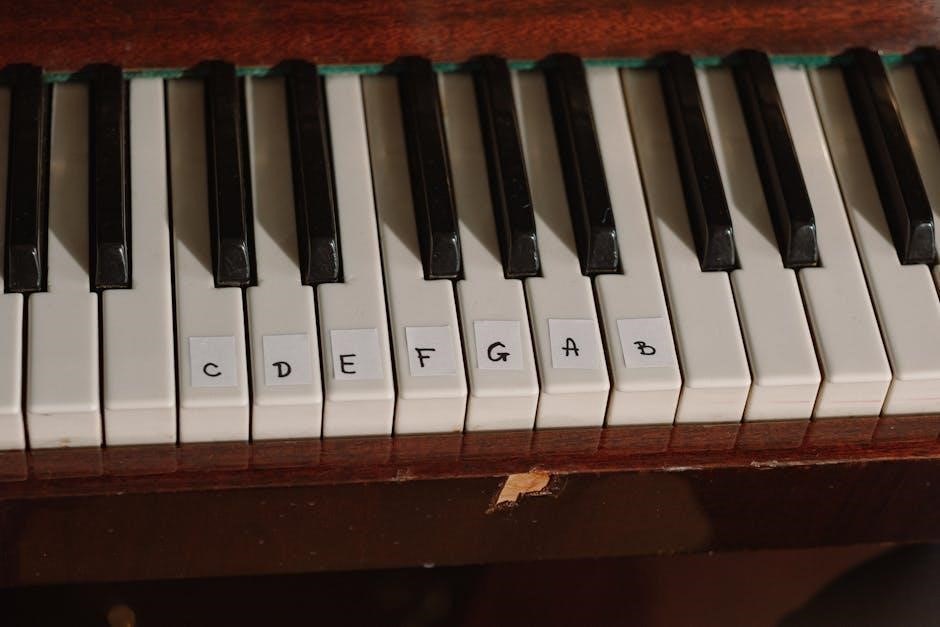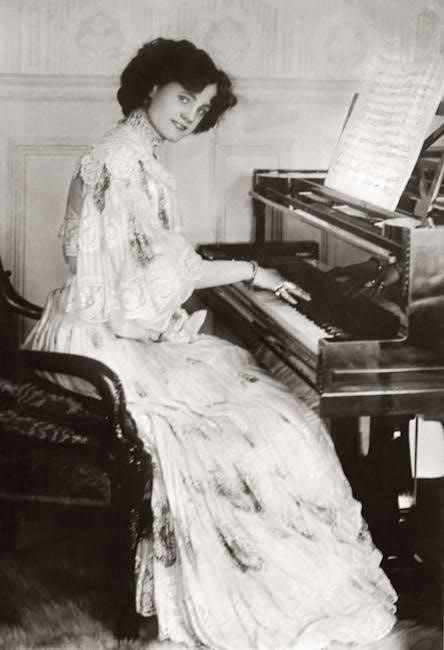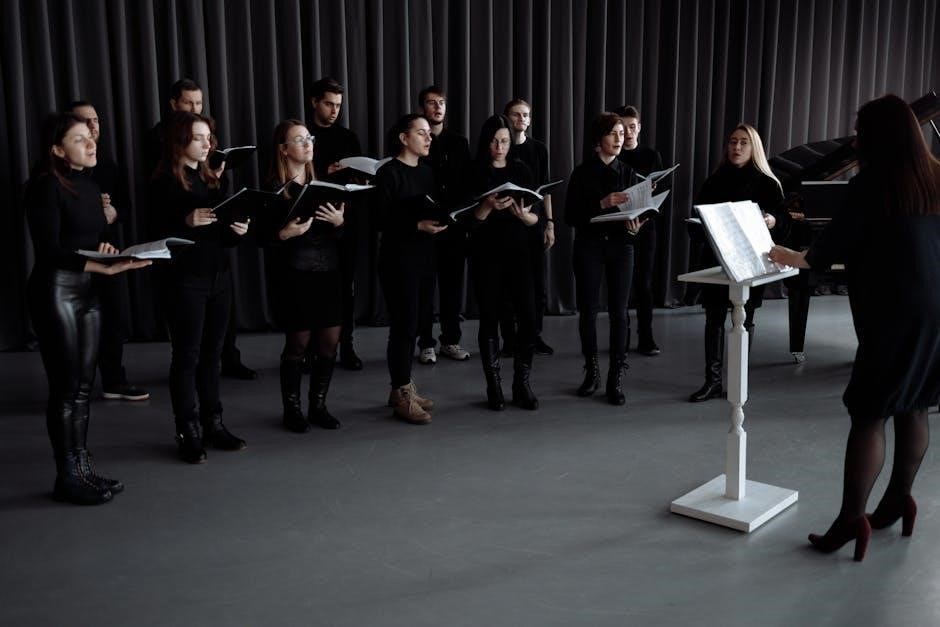
“Rush E” is a captivating piano composition known for its dynamic rhythm and emotional depth, making it a popular choice among pianists seeking technical and expressive challenges.
Overview of the Composition
“Rush E” is a dynamic and emotionally charged piano piece, characterized by its intricate rhythms and melodic layers. The composition showcases a blend of technical complexity and expressive depth, making it a standout work in modern piano repertoire. Its structure is designed to evoke a sense of urgency and energy, with rapid arpeggios and harmonic shifts that challenge even seasoned pianists. The piece is often described as a fusion of classical and contemporary influences, creating a unique listening experience. For pianists, “Rush E” offers a rewarding journey of mastery, combining precision with artistic interpretation. Its popularity stems from its ability to resonate emotionally while pushing technical boundaries.
Historical Context and Popularity
“Rush E” has emerged as a modern piano masterpiece, blending classical techniques with contemporary flair. Its popularity grew rapidly due to its dynamic and emotionally engaging composition, which resonates with both performers and audiences. The piece is often praised for its ability to evoke a sense of urgency and energy, making it a favorite in recitals and competitions. As a result, “Rush E” has become a staple in piano repertoire, with its sheet music widely sought after by pianists of all levels. Its enduring appeal lies in its unique balance of technical complexity and artistic expression, ensuring its place in the ever-evolving world of piano music.
Why “Rush E” is a Favorite Among Pianists

“Rush E” captivates pianists with its intricate harmonies and dynamic rhythm, offering a perfect blend of technical challenge and emotional expression. Its unique structure allows for artistic interpretation, making it a staple in modern piano repertoire. The piece’s ability to evoke powerful emotions while demanding precision resonates deeply with performers. Additionally, its popularity is fueled by the availability of high-quality sheet music, enabling pianists of all levels to engage with the composition. This accessibility, combined with its artistic depth, solidifies “Rush E” as a beloved choice for both practice and performance, ensuring its enduring appeal in the piano community.
Understanding the Structure of “Rush E”
“Rush E” features a dynamic structure with intricate harmonies and rhythmic variations, creating a captivating flow that showcases its emotional depth and technical complexity through well-arranged themes.
Breakdown of the Musical Form
“Rush E” is structured in a dynamic, evolving format that captivates listeners with its intricate layers. The piece begins with a compelling introduction, setting the tone for a dramatic journey. The exposition introduces the main theme, characterized by bold arpeggios and a driving rhythm. As the composition progresses, it transitions into a developmental section where motifs are explored and expanded, showcasing the composer’s mastery of harmonic progression. Climactic moments are punctuated by powerful chords and rapid passages, creating a sense of tension and release. The piece concludes with a reflective coda, tying together the thematic elements in a satisfying resolution. This structure not only highlights technical brilliance but also emotional depth, making “Rush E” a standout piece in piano repertoire.
Key Themes and Motifs
“Rush E” revolves around dynamic contrasts and emotional intensity, with motifs that explore themes of energy and tension. The composition features recurring arpeggio patterns that create a sense of relentless motion, while melodic motifs are developed and transformed throughout the piece. These motifs often shift between lyrical passages and virtuosic flourishes, showcasing the interplay between technical brilliance and expressive depth. The themes are designed to challenge pianists’ dexterity and interpretive skills, making “Rush E” both a technical showcase and an emotional journey. The intricate layering of these elements ensures a captivating experience for both performers and listeners alike, highlighting the piece’s enduring appeal.
Complexity and Technical Challenges
“Rush E” is renowned for its intricate composition, presenting pianists with a multitude of technical challenges. The piece features rapid arpeggios, double thirds, and chromatic passages that demand exceptional finger dexterity and precision. Additionally, its complex rhythms and unexpected key changes require a deep understanding of musical structure and phrasing. Pianists must also navigate dynamic contrasts and nuanced articulations, which add layers of emotional depth to the performance. The physical endurance needed to sustain the piece’s intensity is significant, making it a true testament to a pianist’s skill and artistry. Mastery of “Rush E” is a profound achievement.
How to Play “Rush E” on the Piano

Mastering “Rush E” requires precise finger dexterity, rhythmic accuracy, and dynamic control. Start with slower tempos, focus on complex passages, and gradually build speed and expression.
Tips for Beginner Pianists
Beginners tackling “Rush E” should start by breaking the piece into manageable sections, focusing on hand positioning and finger placement. Practice slowly, emphasizing rhythmic accuracy and dynamic control. Use a metronome to build tempo confidence gradually. Pay attention to complex passages, repeating them until comfortable. Seek tutorials or guides for technical guidance. Prioritize proper posture and relaxation to avoid fatigue. Record sessions to track progress and identify areas for improvement. Celebrate small achievements to stay motivated. Regular practice, even for short durations, is key to mastering this piece. Embrace challenges as opportunities to grow and refine your skills.
Advanced Techniques Required
Mastery of “Rush E” demands advanced techniques such as intricate arpeggios, complex chord progressions, and rapid scale passages. Pianists must excel in nuanced pedaling to achieve dynamic contrasts and tonal depth. The piece requires precise control over articulation, with alternating legato and staccato sections. Advanced finger dexterity is essential for executing double thirds and chromatic runs seamlessly. Additionally, a strong sense of rhythm and timing is crucial to navigate the composition’s shifting tempos and syncopations. Proficiency in polyrhythms and layered melodies further enhances the performance. These challenges make “Rush E” a rewarding piece for skilled pianists aiming to showcase their technical and musical prowess.
Practice Strategies for Mastery
To master “Rush E,” pianists should adopt structured practice strategies. Begin by breaking the piece into manageable sections, focusing on technically demanding passages. Use a metronome to refine timing and rhythm, gradually increasing tempo as confidence grows. Slow practice is essential for accuracy, while faster tempos can be introduced once control is achieved. Incorporate finger exercises like Hanon or Czerny to build dexterity. Record sessions to identify areas for improvement and maintain consistent practice routines. Emphasize dynamic contrasts and phrasing to enhance musicality. Over time, these strategies will help pianists achieve a polished and expressive performance of “Rush E.”

Where to Find “Rush E” Piano Sheet Music
Official sheet music for “Rush E” is available through reputable publishers and online platforms like Musicnotes and Sheet Music Plus, ensuring high-quality downloads for pianists.
Official Sources and Publishers
Official sheet music for “Rush E” is available through reputable publishers like Musicnotes and Sheet Music Plus, ensuring authenticity and quality. These platforms offer downloadable PDF versions, making it convenient for pianists to access the piece. Purchasing from official sources guarantees accurate notation and supports the creators. Additionally, many publishers provide bundled editions with performance notes, enhancing the learning experience. Always verify the publisher’s credibility to avoid unauthorized copies. Official sources are the best way to obtain “Rush E” sheet music, ensuring a seamless and lawful learning process for pianists of all levels.
Free Resources and Websites
Several websites offer free access to “Rush E” piano sheet music in PDF format, though quality and accuracy may vary. Platforms like MuseScore and IMSLP provide user-uploaded scores, often downloadable for free. These sites are popular among pianists seeking affordable options. However, be cautious of unofficial arrangements, as they may lack the original composer’s intent. Free resources are ideal for initial exploration but may not offer the same precision as official versions. Always verify the source’s credibility to ensure you’re using a reliable and legally shared document. Free sheet music websites are a great starting point for pianists on a budget.
Legal Considerations for Sheet Music
Using copyrighted sheet music like “Rush E” requires adherence to legal standards. Downloading or distributing copyrighted material without permission is illegal and can lead to legal consequences. Ensure you obtain sheet music from official sources or licensed publishers to avoid infringement. Respect intellectual property rights by purchasing or accessing sheet music through legitimate channels. Free downloads may violate copyright laws if not authorized by the composer or publisher. Always verify the legality of the source to support creators and comply with regulations. Public domain works are exempt, but “Rush E” may not fall under this category. Legal compliance ensures fair access and supports artistic creation.
The Importance of Sheet Music in Learning
Sheet music serves as a guide, providing structure and clarity for pianists to learn compositions accurately. It ensures precise interpretation of timing, dynamics, and composer intent, fostering mastery.

Role of Sheet Music in Musical Education
Sheet music is a cornerstone of musical education, offering a visual representation of compositions that guides pianists in understanding notes, rhythms, and dynamics. It provides a foundation for practice, enabling learners to grasp complex pieces like “Rush E” accurately. By following sheet music, pianists develop sight-reading skills, theoretical knowledge, and technical proficiency. It also ensures that musical interpretations remain faithful to the composer’s intent, preserving artistic vision and historical context. For educators, sheet music serves as a teaching tool, facilitating structured lessons and fostering musical growth. Its availability in formats like PDF has made it accessible, aiding both beginners and advanced pianists in their musical journeys.
Challenges of Playing Without Sheet Music
Playing “Rush E” without sheet music presents significant challenges, particularly in maintaining accuracy and nuance. Pianists must rely heavily on memory, which can lead to errors in complex passages. Without visual cues, interpreting dynamics, tempo, and articulation becomes difficult, risking misrepresentation of the composer’s intent. Technical precision, especially in intricate sections, may suffer, and subtle musical details could be overlooked. Additionally, learning the piece without sheet music demands extensive time and effort, as memorization requires repeated practice. This approach can hinder the learning process, making it harder to master the piece effectively compared to using sheet music as a guide.
Resources for Intermediate Learners
Intermediate pianists seeking to master “Rush E” can benefit from a variety of resources. Official sheet music publishers like Musicnotes and Sheet Music Plus offer high-quality PDFs, ensuring accuracy and clarity. Additionally, video tutorials and online lessons from platforms like YouTube and Piano Nanny provide step-by-step guidance. Websites such as Piano Marvel and HDpiano cater specifically to intermediate learners, offering detailed breakdowns of complex sections. These resources not only enhance technical proficiency but also deepen musical understanding, helping pianists refine their interpretation and performance of “Rush E.” Utilizing these tools can significantly accelerate the learning process and improve overall musicianship.

The Impact of “Rush E” on Modern Music
“Rush E” influences contemporary composers by blending dynamic rhythms with emotional depth, inspiring new works and fostering creativity among modern pianists and music enthusiasts globally.
Influence on Contemporary Composers
“Rush E” has become a benchmark for contemporary composers, inspiring them to explore dynamic rhythms and emotional depth. Its intricate structure and technical demands challenge modern musicians to innovate, blending tradition with experimentation. The piece’s accessibility and adaptability have led to numerous reinterpretations, fostering creativity across genres. Composers often draw inspiration from its layered melodies and harmonic complexity, incorporating similar techniques into their own works. This influence extends beyond classical music, with elements of “Rush E” appearing in film scores, electronic music, and even educational materials. Its enduring popularity ensures its continued impact on the evolution of modern music composition.

Community and Fan Engagement
The “Rush E” piano piece has fostered a vibrant community of enthusiasts who share their interpretations and experiences online. Fans actively engage through forums, social media, and live events, creating a supportive environment for pianists of all levels. Many enthusiasts upload their performances on platforms like YouTube, inspiring others to take on the challenge. The piece’s popularity has also led to collaborative projects, where fans collectively explore its nuances. This shared passion has strengthened the bond among music lovers, turning “Rush E” into more than just a composition—it’s a cultural phenomenon that continues to unite people worldwide through the universal language of music.
Cultural Significance and Legacy
“Rush E” has become a cornerstone of modern piano repertoire, inspiring countless pianists and composers. Its unique blend of technical brilliance and emotional resonance has cemented its place in musical history. The piece transcends generations, appealing to both classical purists and contemporary enthusiasts. Its influence is evident in the work of many modern composers, who draw inspiration from its innovative structure and expressive depth. As a result, “Rush E” continues to shape the evolution of piano music, ensuring its legacy as a timeless masterpiece. Its widespread availability in sheet music form has further solidified its impact, making it accessible to pianists worldwide.

“Rush E” remains a timeless piece, captivating pianists with its brilliance. Its sheet music is a vital resource for mastering this iconic work, inspiring future generations to embrace its beauty and complexity, ensuring its lasting legacy in piano repertoire.

Summarizing the Journey of “Rush E”
“Rush E” has emerged as a significant piano piece, captivating audiences with its intricate composition and emotional depth. Created to challenge technical prowess, it has gained popularity among pianists worldwide. The piece embodies a blend of dynamic rhythms and melodic elegance, making it both a joy and a test for performers. Its rise to prominence reflects the enduring appeal of classical music in modern times. Pianists often describe “Rush E” as a transformative experience, pushing their skills to new heights. The availability of its sheet music has democratized access, allowing aspiring musicians to engage with this masterpiece. Its legacy continues to inspire, ensuring its place in the piano repertoire for years to come.
Encouragement for Aspiring Pianists

Embarking on the journey to master “Rush E” is a rewarding endeavor for pianists of all levels. This piece offers a unique opportunity to refine technical skills while expressing deep emotion. Aspiring pianists are encouraged to embrace the challenge, as it fosters growth and musical understanding. Start with patience, breaking the composition into manageable sections. Consistent practice will unlock its beauty and complexity. Utilize available resources, such as sheet music and tutorials, to guide your progress. Remember, mastery takes time, but the satisfaction of performing “Rush E” is unparalleled. Celebrate small victories and enjoy the transformative power of music.
Future of “Rush E” in Piano Repertoire
“Rush E” is poised to remain a cornerstone of piano repertoire, thanks to its timeless appeal and accessibility through sheet music. Its digital presence ensures it will inspire future generations, blending technical challenge with emotional depth. As pianists continue to embrace the piece, it will evolve, influencing new compositions and interpretations. The widespread availability of “Rush E” in PDF format makes it a staple for both education and performance, solidifying its legacy in modern piano music. Its enduring popularity guarantees it will remain a beloved and integral part of pianists’ repertoires for years to come.




